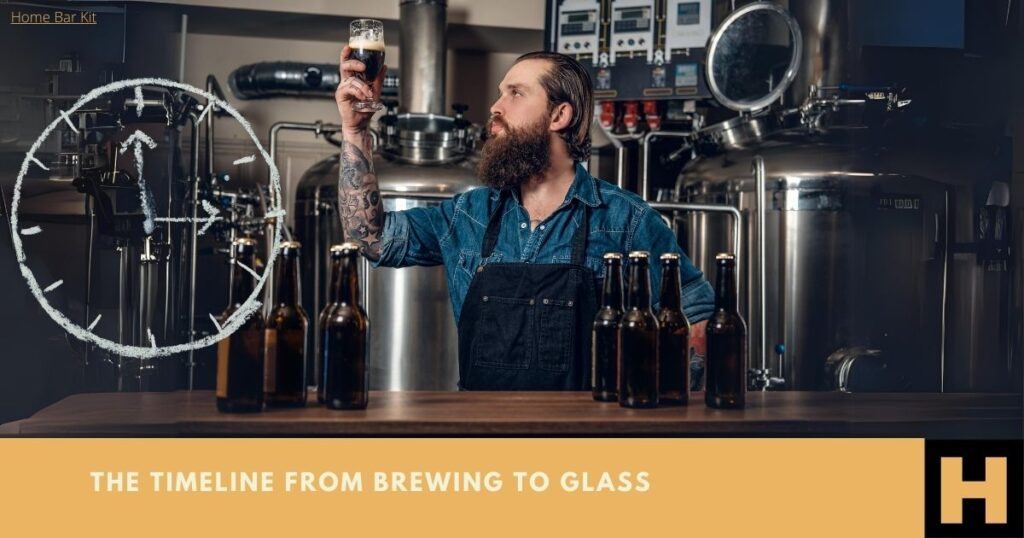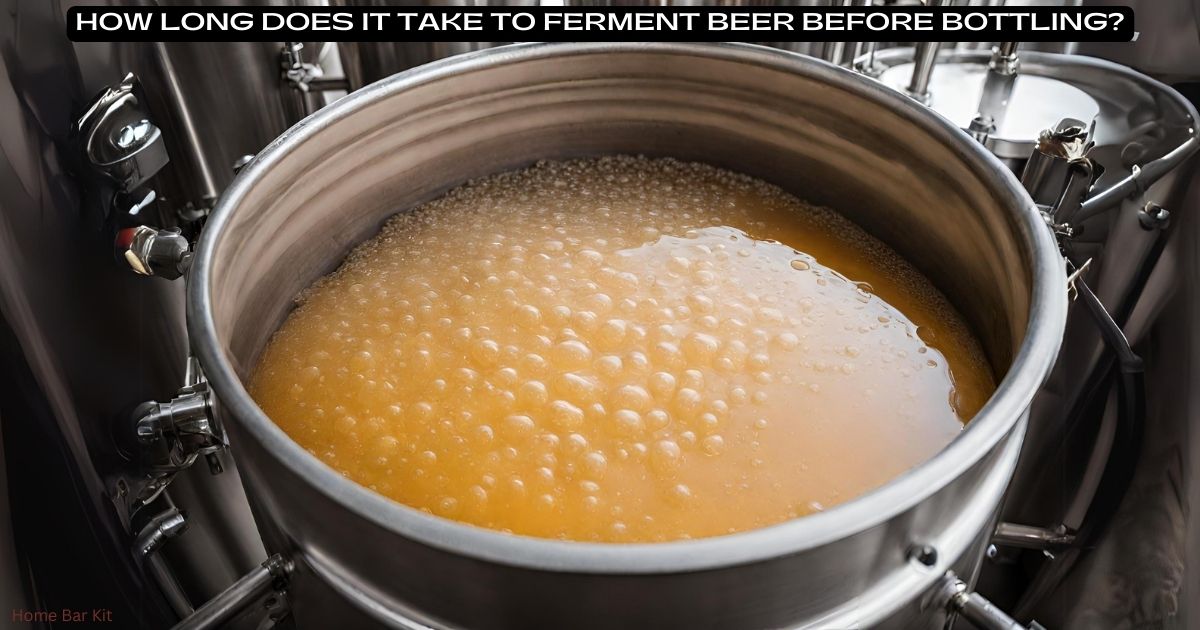Once a beer has been brewed, the fermentation process can take from one week to several months before it is ready for bottling. This may seem a little broad, but it depends on the type of beer you are brewing, and whether you are going for a secondary fermentation.
A light ale, like pale ale might take just a week to ferment, whereas a darker ale or stout might take longer. A lager will take longer still, maybe several months because it is fermented at a lower temperature.
Yeast, the main ingredient of beer fermentation, consumes sugars to produce alcohol and CO2. Ales are fermented at warmer temperatures so will ferment quicker. Lagers are fermented at lower temperatures which means they will take longer to ferment.
Table Of Contents
- Primary and Secondary Fermentation
- When Is My Beer Ready To Bottle?
- Can You Ferment Beer For Too Long?
- The Timeline From Brewing to Glass
- Summarizing the Fermentation Journey
The fermentation process usually unfolds in two distinct stages: primary and secondary.
Primary and Secondary Fermentation
When you brew your own beer, understanding the fermentation process is important. Primary and secondary fermentation are two stages that each serve a purpose in the development of your beer’s flavour, alcohol content, and clarity.
During primary fermentation, which typically lasts one to two weeks, yeast is most active. You can gauge the fermentation by observing the bubbling in the airlock, the thick foamy layer on top of the beer, and eventually a reduction in these activities.
Strains of yeast, fermentation temperature, and the gravity of the beer are among key factors that can speed up or slow down this phase.
Primary fermentation kicks off immediately after you’ve cooled your wort (the sweet liquid extracted from mashing grains) and added your yeast.
Yeast is a greedy beast; it feasts on the sugars in the wort, producing alcohol and carbon dioxide as a result. This stage is usually vigorous and can last anywhere from a few days up to two weeks, depending on factors like the yeast strain, temperature, and the type of beer you’re brewing.
Primary fermentation is when most of the magic happens, transforming sweet wort into beer.
Secondary fermentation is where expectations meet patience. Some skip this step, but for many, it’s a two to three-week period of waiting. This allows flavours to mature and the beer to clear.
While the active bubbling might cease, yeast continues its work, clearing up the residual byproducts and contributing to the beer’s final taste profile.
Once the frenzy of primary fermentation subsides, the beer enters secondary fermentation. This stage is less about transformation and more about refinement.
By transferring your beer to a new vessel, you’re allowing it to age without the influence of the yeast sediment that has settled at the bottom of the primary fermenter. Secondary fermentation can enhance flavour, improve clarity, and encourage the development of more complex characteristics in your beer.
Typically, this stage takes an additional one to two weeks, but beers with higher alcohol content or those that benefit from maturation, like stouts or barley wines, may take longer.
The transition between primary and secondary fermentation is delicate. It highlights the balance between giving the yeast enough time to do its job without exposing the beer to potential off-flavours from sitting too long on the yeast cake. It’s important to monitor and determine the right time to make this move.
But it is a move I do make, in my experience I get a better result if I let the beer go through a secondary fermentation.
When Is My Beer Ready To Bottle?

Knowing when beer is ready to move into bottles is not always an easy call. Bottling too early can lead to over-carbonation or even exploding bottles, while bottling too late might mean a beer that’s flat or has diminished hop character.
There are some signs to look out for to make the right call.
Visibility is one. When the beer starts to clear and the sediment forms a distinct layer at the bottom, it’s a visual cue that fermentation is nearing its end.
However it is not always best to trust by eyes alone. Measuring the specific gravity is how you can confirm it’s time.
Using a hydrometer or a refractometer to take gravity readings on consecutive days is a good idea. If the readings are consistent, it suggests the yeast has done its job. Look for the beer to reach the final gravity as stated by the beer recipe or style guide.
The airlock is a good indicator too. A slow-down in bubbling frequency indicates that fermentation is subsiding. However, it’s not foolproof because temperature drops and other factors can also slow bubbling without meaning the beer is ready.
At the end of the day, it’s about bringing together these methods to make an informed decision. You can wait an extra couple of days after these signs align just to be sure.
Can You Ferment Beer For Too Long?
You might worry about leaving your beer to ferment for too long. It’s a valid concern. Over-fermentation can have negative impacts, but it’s important to understand what that really means.
Fermentation that extends beyond the typical window isn’t inherently harmful. The primary risk is that the yeast, having consumed all available sugars, begins to die and break down. The result can be undesirable flavours often compared to rubber or meat.
Another risk is the introduction of oxygen during long fermentation periods, which can lead to oxidation. Oxidation in beer manifests as stale, cardboard-like flavours. This happens most frequently in cases where beer is transferred to a secondary vessel and not adequately shielded from the air.
However, the timeline for these issues is quite generous. We’re not talking about days or even weeks beyond the standard fermentation period, but rather months. In most home-brewing scenarios, such extended periods are unnecessary and easily avoided with careful monitoring.
So keep a close eye on your beer. If primary fermentation is complete and the beer has cleared, consider bottling it to prevent any risk of the yeast breaking down or oxidation.
The Timeline From Brewing to Glass

There are four main steps to brewing beer, and each one needs to be complete before your beer hits the glass and you enjoy.
1. Brewing: This is where your journey begins. You combine malt, hops, water, and yeast to create what’s known as wort. Brewing day typically takes about 2 to 4 hours, culminating in the wort being cooled and transferred to a fermentation vessel.
2. Fermenting: The length of this stage varies, but generally, primary fermentation can take anywhere from 1 to 2 weeks. After that, secondary fermentation, which is optional, can take an additional 1 to 3 weeks. It’s during these stages that the wort officially transforms into beer.
3. Bottling: Once your beer has fermented and cleared, it’s ready for bottling. This stage can take a couple of hours, depending on your set up and the volume of beer. Remember, cleanliness is key to prevent contamination.
4. Conditioning in Bottle: After bottling, your beer isn’t done just yet. It needs time to carbonate and mature, which is known as bottle conditioning. This can take around 2 to 4 weeks. During this time, flavours can fuse and harsh notes can mellow, often significantly improving the quality of your beer.
These timeframes are approximate and can be influenced by the beer style, the yeast strain used, and your specific brewing conditions. Be Patient, rushing any of these steps might not provide the best results.
Summarizing the Fermentation Journey
The key to successful home brewing lies in the fermentation process. Generally, fermentation can take anywhere from a week to several months, depending upon the beer style and desired flavour profile.
It is hard to wait for your beer to do its thing, but patience really is important in brewing. Don’t rush the process; the primary stage sets the foundation, while secondary fermentation refines and matures the beer.
Don’t go by an exact time for your beer to be ready because it can vary. Your instruments and visual checks will tell you when your beer is ready for bottling.
Keeping an eye on the calendar is important, but it’s not just about marking time. It’s about making sure each stage of fermentation is done correctly and given the time to complete properly.
So take your time, monitor your brew, and when all signs point to readiness, go ahead and bottle that beer. Then let it condition for up to four weeks before you let beer meet glass.
It is hard to wait for these processes, but worth it in the end because the look and taste of your beer will tell the story.
If you have any brewing tips and/or question, then do share them below.
Rob is a passionate home bar and pub shed enthusiast with a passion for craft beer. With hands-on experience in designing and building his own home bar, Rob shares his knowledge, tips, and inspiration to help fellow enthusiasts create their own perfect space. Alongside the world of home bars and pub sheds, Rob also explores the diverse and exciting realm of craft beer, providing honest reviews to help you discover your next favorite brew. Join Rob on a journey of flavor, design, and craftsmanship right here on Home Bar Kit.

